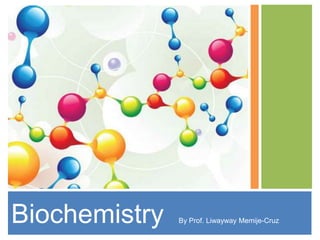
The Essentials of Biochemistry
- 1. The Essentials of Biochemistry By Prof. Liwayway Memije-Cruz
- 2. Biochemistry is the branch of science that explores the chemical processes within and related to living organisms. It is a laboratory based science that brings together biology and chemistry. By using chemical knowledge and techniques, biochemists can understand and solve biological problems.
- 4. Respiration
- 5. Carbohydrates, Lipids and Proteins Organic Compounds
- 7. Carbohydrates means hydrated carbons; examples are glucose (C6 H12O6) and ribose (C5H10O5). They provide an easy and ready to use source of food.
- 8. Monosaccharides are commonly referred to as simple sugars. Examples are: Glucose – blood sugar which is the universal cellular fuel Fructose - converted to glucose for used by body cells. Galactose Ribose - form part of the structure of nucleic acids. Deoxyribose
- 9. Glucose, Fructose and Ribose MONOSACCHARIDES
- 10. Disaccharides are referred to as double sugars. Some of the important disaccharides in the diet include: Sucrose (glucose-fructose), which is cane sugar. Lactose (glucose-galactose) found in milk. Maltose (glucose-glucose) malt sugar. Disaccharides must be broken down (digested) to monosaccharide to be absorbed from the digestive tract in to the blood.
- 11. Sucrose, Lactose and Malt sugar DISACCHARIDES
- 12. Polysaccharide, which literally means much sugar, is a polymer of linked monosaccharides. Starch is the storage polysaccharide formed by plants as starchy foods like grains and root vegetables (potatoes and carrots). Glycogen is found in animal tissues like in the muscles and the liver.
- 14. Lipids: The most abundant lipids in the body are:
- 15. Lipids are organic compounds composed of carbon, hydrogen and oxygen. They are a large and diverse group of organic compounds composed of fatty acids and glycerol. They may be solid or liquid. Most of them are insoluble in water but readily dissolve in other lipids, and in organic solvents like alcohol, ether and acetone.
- 16. 1. Neutral Fats (triglycerides) They represent the body’s most abundant and concentrated sources of usable energy. They are stored chiefly in fat deposits beneath the skin and around body organs where they help insulate the body and protect deeper body tissues from heat loss and bumps. 2. Phospholipids They are modified lipid containing phosphorous. Their presence in cellular membrane allow cells to be selective about what may enter or leave. They are found in the brain and the nervous tissue where they help to form insulating white matter.
- 17. 3. Steroids. They are specific groups of chemical substances. They include certain hormones and cholesterol. Cholesterol – the basis of all body steroids. Found in all membranes, and abundant in the brain. Bile salts - breakdown product of cholesterol that is released by the liver into the digestive tract where they aid in fat digestion and absorption. Vitamin D – produced in the skin on exposure to ultra violet radiation from modified cholesterol. Necessary for normal body growth and function. Sex hormones –produced from cholesterol, which include estrogen and progesterone that are vital for normal reproductive function. Lack of sex hormones may results to sterility. Adrenal cortical hormones – composed of cortisol, a long- term antistress hormone necessary for life and aldosterone that helps regulate salts and water balance in the body fluids by the targeting the kidneys.
- 18. OTHER LIPOID SUBSTANCES INCLUDE: FAT-SOLUBLE VITAMINS: Vitamin A - found in orange – pigmented vegetables (carrots) and fruits (tomatoes) and part of the photoreception pigments involved in vision. Vitamin E - found in wheat germ and green leafy vegetables that promote wound healing and contribute to fertility. It may help to neutralize free radicals and believed to the involved in triggering some types of blood. Vitamin K - made available largely by the action of intestinal bacteria, it is also present in a wide variety of food and is necessary for proper blood clotting. Prostaglandin derivatives of fatty acids found in cell membranes, which stimulate uterine contraction, regulate blood pressure and control stomach secretion and motility of the gastrointestinal tract.
- 20. PROTEINS
- 21. Proteins are complex nitrogenous substances that are accounted for over 50% of the organic matter in the body. Amino Acids are small molecules that are the building blocks of proteins. 20 common types of amino acids are found in the body. The amino acids released through protein digestion are absorbed and used to build the body’s proteins. Of the common amino acids, eight are essential amino acids. Our body cannot build these molecules; they should be obtained from the diet.
- 22. – Transport proteins carry iron, cholesterol and other substances in the body. Example is hemoglobin, which helps in the transport of oxygen in the blood. – Contractile proteins are involved in cell division and sperm propulsion. Actin and myosin are substances essential for muscle contraction and body movement. – Catalyst is essential for every biochemical reaction in the body. A catalyst is a substance that increases the rate of a chemical reaction without becoming part of the product or being changed itself.
- 23. Nucleic acids
- 24. Thank you!
